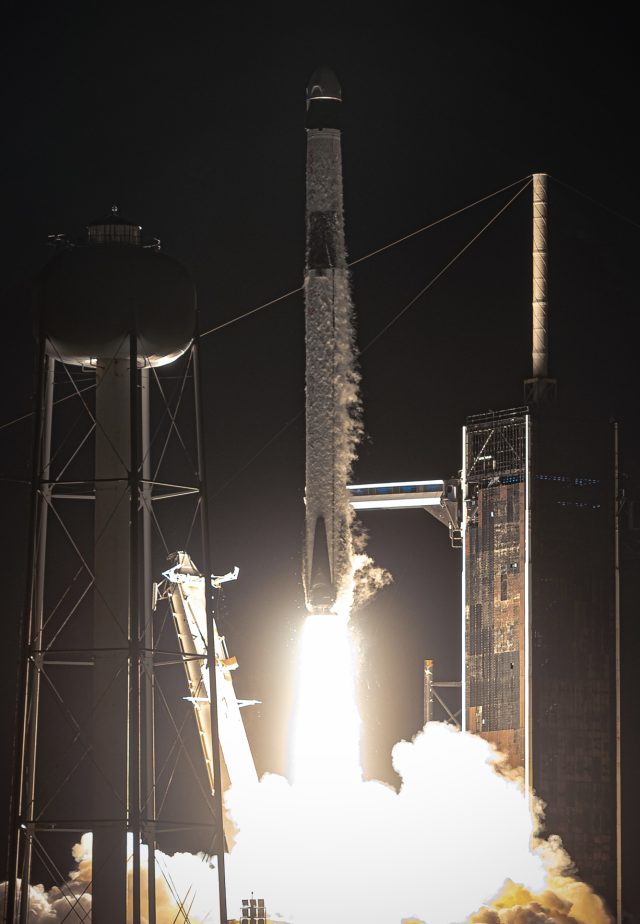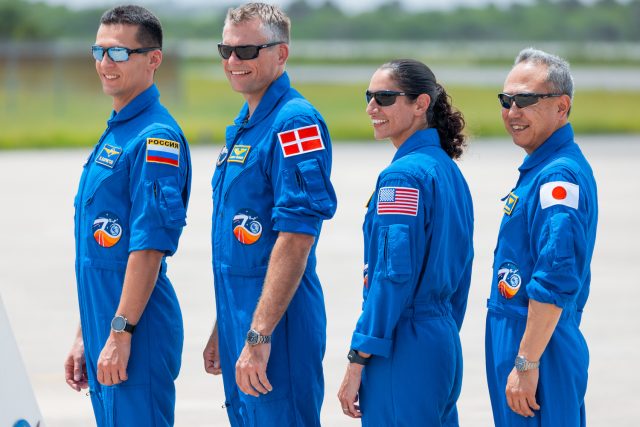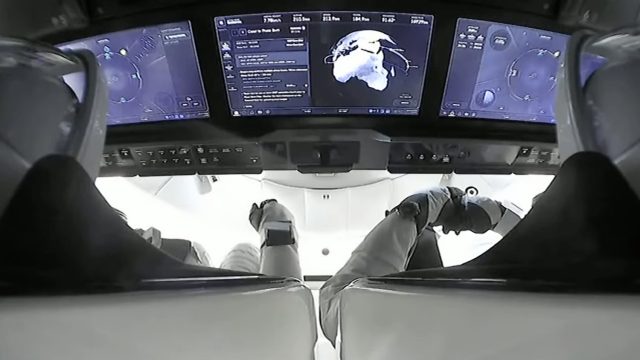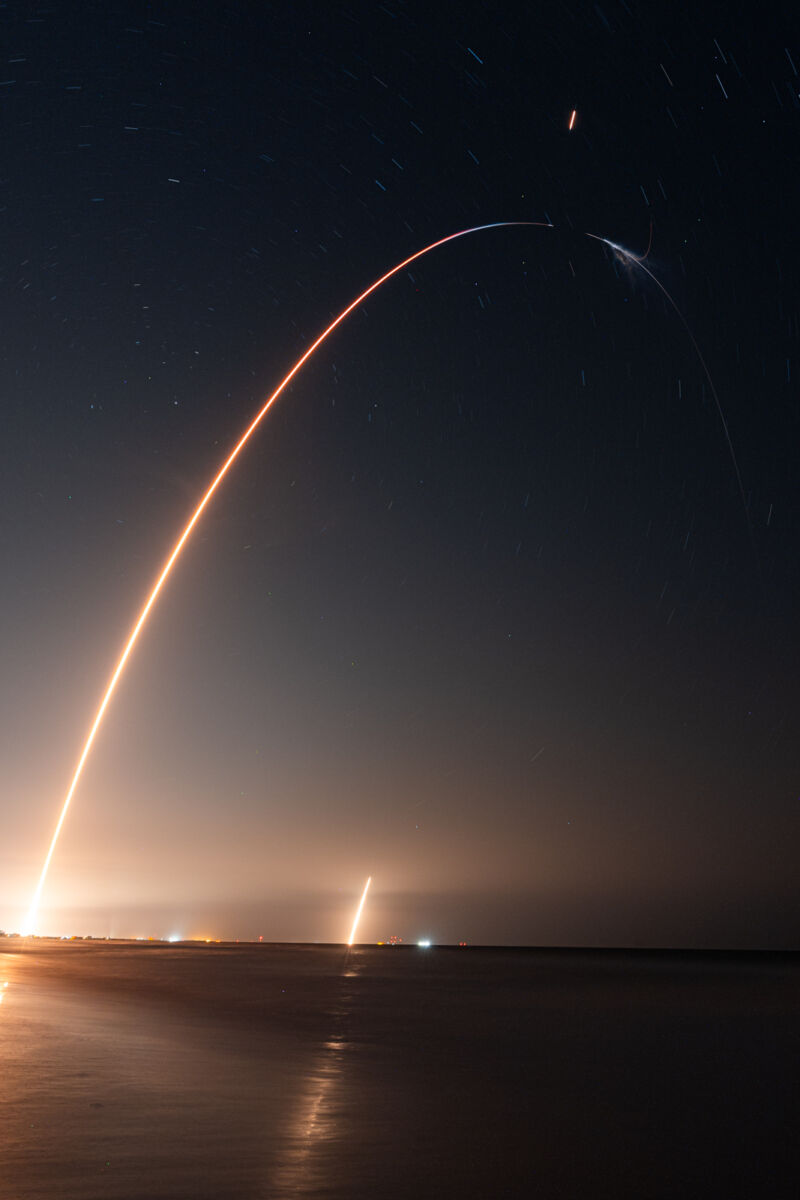SpaceX launched a Dragon spacecraft into orbit from Florida’s Space Coast early Saturday, carrying a multinational crew from the United States, Denmark, Japan, and Russia on a flight to the International Space Station.
The four crew members strapped into their seats inside SpaceX's Crew Dragon Endurance spacecraft overnight and then waited for a Falcon 9 rocket to shoot them into orbit from NASA's Kennedy Space Center. With a flash of orange light, the rocket's nine kerosene-fueled Merlin engines ignited and propelled the Falcon 9 off the launch pad at 3:27 am EDT (07:27 UTC).
The rocket headed northeast from the Florida coast to arc over the Atlantic Ocean and line up with the flight path of the International Space Station. About two-and-a-half minutes into the launch, the Falcon 9's first stage booster separated from the rocket's upper stage to begin thrusting back toward Cape Canaveral. The return maneuver culminated in an on-target vertical landing a few miles south of the launch pad.
Into orbit
This was the first flight of a brand new Falcon 9 booster, joining more than 15 reusable boosters in SpaceX's rotation, an inventory that has helped enable an average of one launch every four days this year.
After ditching the first stage, the Falcon 9's upper stage accelerated the Dragon crew capsule to orbital velocity, then released the spacecraft to begin a pursuit of the space station. If all goes according to plan, the Crew Dragon Endurance spacecraft—making its third flight to orbit—will link up with the space station Sunday to deliver a fresh four-person crew to the outpost for a six-month stay.
NASA astronaut Jasmin Moghbeli commands the crew. She is joined by Danish astronaut Andreas Mogensen representing the European Space Station, Japanese astronaut Satoshi Furukawa, and Russian cosmonaut Konstantin Borisov.
At the space station, the crew will work on hundreds of scientific experiments, perform maintenance tasks, and venture outside on spacewalks. Saturday morning's flight was the 11th SpaceX launch to carry people into space, and SpaceX's seventh operational crew rotation for NASA to the space station, a number that gives the mission its name: Crew-7.
The Crew-7 team will replace the Crew-6 mission, which has been living and working on the space station since March. Upon arrival of the new crew, the Crew-6 team will pack up their Dragon capsule for return to Earth in early September.

The launch of Crew-7 was delayed about 24 hours to allow more time for SpaceX and NASA engineers to complete an assessment of valves in the Dragon spacecraft's environmental control and life support system. Concerns about valves have recently been top of mind for SpaceX and NASA officials after several in-flight malfunctions. A NASA spokesperson said SpaceX reviewed test data on all the valves on the Dragon spacecraft, and the work to look at the life support system valves took longer than expected. That led officials to keep the Crew-7 mission on the ground one more day.
With the four-person crew already strapped into their seats, SpaceX's launch team cleared another technical issue with less than two minutes remaining in Saturday's countdown. A sensor at the launch pad detected a possible leak of nitrogen tetroxide, the toxic propellant used for the Dragon spacecraft's thrusters. Engineers determined the leak, if there was one at all, was too minor to be of any consequence for the mission.
A crew of four
Moghbeli, a lieutenant colonel in the US Marine Corps, is commander of the Crew-7 mission on her first flight to space. The 40-year-old astronaut was a Marine Corps helicopter test pilot before her selection as a NASA astronaut in 2017. She is the daughter of Iranian parents who fled their home country after the 1979 Iranian Revolution.
She said she hopes her mission will inspire children still in Iran, and is bringing Persian food to share with her crewmates in orbit.
"Something I didn’t recognize is it’s really important for kids to see someone they connect to in some way, whether that’s Iranian girls or Iranian children looking up to me because I’m also Iranian and realizing they, too, can do this," Moghbeli said.
Moghbeli calmly called out milestones as she rocketed into orbit Saturday, until the Falcon 9 launcher shut down its upper stage and the crew members got their first taste of microgravity.
“SpaceX, thanks for the ride," Moghbeli radioed SpaceX mission controllers moments after arriving in orbit. "We may have four crew members on-board from four different nations—Denmark, Japan, Russia, and the USA—but we’re a united team with a common mission.”
The Crew-7 mission is the first time four nations have been represented on a single flight of SpaceX's four-seat Dragon capsule. Overall, it's the first time since a 2001 space shuttle flight that crew members from four countries have launched on the same mission.
Borisov, 39, is a rookie cosmonaut flying on the SpaceX mission as part of a no-funds-exchanged seat-swapping agreement between NASA and the Russian space agency, Roscosmos. This deal allows US astronauts to launch on Russian spacecraft and Russian cosmonauts to fly on US crew vehicles, ensuring at least one crew member from each major partner is always present on the space station, even if SpaceX or Russia ground their rockets.
Speaking with Ars before the launch, Borisov said there have been "no challenges" in training for his flight to the space station, despite the deterioration in US-Russian relations on Earth. "It has been both very relaxed and very professional," he said. "I want to point out that it's really important that we continue that relationship."

NASA arranges rides for astronauts from other space station partners based on their investment in the orbiting research outpost. ESA astronaut Andreas Mogensen and Satoshi Furukawa from the Japan Aerospace Exploration Agency, or JAXA, round out Crew-7.
Mogensen is 46 and flew to the space station in 2015 for a relatively short 10-day mission. He worked as an engineer on offshore oil rigs early in his career, then was an aerospace engineer working for several space companies until ESA selected him as an astronaut in 2009. Furukawa, a 59-year-old former surgeon, is the most experienced member of the new space station crew with 165 days in orbit on a previous mission.
Soyuz vs. Dragon
With the Crew-7 launch, Mogensen became the first international astronaut to fly in the pilot's seat on a SpaceX Dragon spacecraft. The Dragon flight to the space station will be fully automated if everything goes according to plan, but Moghbeli and Mogensen are trained to take over manual control of the capsule if necessary. On such an occasion, the commander would be primarily tasked with manually flying the Dragon spacecraft using the ship's touchscreen displays.
That makes Mogensen essentially the Dragon spacecraft's co-pilot, the same position he served in during his first flight to space on a Russian Soyuz spacecraft. The Soyuz was the only vehicle capable of ferrying crew members to and from the space station from 2011 until 2020.
Mogensen is one of just a handful of astronauts who have direct experience with Soyuz and Dragon.

“Soyuz and Dragon are two very, very different spacecraft, principally because one, Soyuz, was developed in the late ‘60s and early ‘70s, and Dragon was developed in the last 10 years," Mogensen said. "Soyuz has, in the past, at least, relied on ground stations for radio communication, which means that for maybe half of the flight, the astronauts on-board Soyuz have to be ... able to work independently, which means that any problems that arise during flight, they have to be able to solve on their own. So it requires an incredibly intricate knowledge of all the systems on-board Soyuz."
A larger network of ground stations and NASA-owned relay satellites keeps SpaceX's Dragon spacecraft in touch with mission control on a near-continuous basis. That means SpaceX engineers on the ground can troubleshoot problems as they are arise in orbit.
On Soyuz, "we studied all the way down to the wiring diagrams, and we understand exactly where signals go from one piece of equipment to another in order to truly understand to the level of detail, where if something goes wrong, we can fix it on our own," Mogensen said. "With Dragon, we can utilize the expertise of the Dragon mission controllers in Hawthorne (California) because we have almost constant radio communication with them.
"Also, the design of Dragon itself, it's all software based, in many ways like Tesla," Mogensen said. "In the same ways that Tesla can send out software updates that change the way a Tesla car drives, they (SpaceX) can they can send software commands to Dragon and do a lot of the troubleshooting. So we don't have to know the spacecraft to the same level of detail that we had to know Soyuz in.”
Listing image by Trevor Mahlmann/Ars Technica



3175x175(CURRENT).thumb.jpg.b05acc060982b36f5891ba728e6d953c.jpg)

Recommended Comments
There are no comments to display.
Join the conversation
You can post now and register later. If you have an account, sign in now to post with your account.
Note: Your post will require moderator approval before it will be visible.